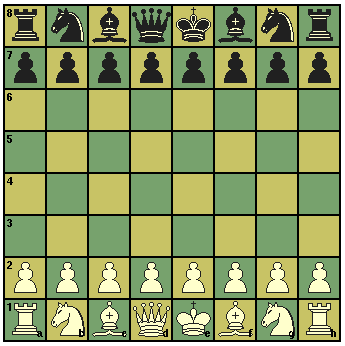
 |
The board used in the game of chess consists of eight rows and eight columns of squares arranged in alternating colors. The colors are called "black" and "white", although the actual colors are usually dark green and buff for boards used in competition, and often natural shades of light and dark woods for home boards. Some play sets may use red and black, which is also used for checkers.
The board is always placed so that the rightmost square on the row nearest each player is a "white" square.
In modern commentary, the columns (called files) are labeled by the letters a to h from left to right from the white player's point of view, and the rows (called ranks) by the numbers 1 to 8 from the white player's point of view, thus providing a standard notation called Algebraic chess notation.
In older English commentary, the files are labeled by the piece originally occupying its first rank, and ranks by the numbers 1 to 8 from each player's point of view, depending on the move being described. This is called English chess notation, and is no longer commonly used.
At the start of the game, the pieces are arranged in ranks 1 and 2 as follows:
Rank 1 contains rook, knight, bishop, queen, king, bishop, knight, and rook in this order from left to right. The three pieces on the Queen's side are called "queen's rook", "queen's knight" etc., and the other pieces are "king's rook", "king's bishop", etc. Rank 2 contains eight pawns. Black's pieces on ranks 7 and 8 are a mirror image of white's. In particular, both kings share the same file (file e), as do both queens (on file d). This is often remembered by noting that each queen sits on a square of her own color.
The image at the top of this page is a graphical representation of this starting position, with the files and ranks labeled. By convention, diagrams display the starting position of the white pieces at the bottom of the board.